A Statistical Analysis of Plasma Bubbles Observed by Swarm Constellation during Different Types of Geomagnetic Storms
Abstract
:1. Introduction
2. Data and Methodology
2.1. Swarm Satellite Mission
2.2. IBI Selection Criterion
2.3. COSMIC Mission
3. Results
3.1. The Occurrence Rate of IBIs during Different Types of Geomagnetic Storms
3.2. The Local Time Variations of the Occurrence and the Duration Time of IBIs Observed during Different Types of Geomagnetic Storms
3.3. Seasonal Variations of IBIs at the Altitudes of Swarm Satellites in Both Hemispheres
3.4. A Qualitative Investigation of IBI Events Using Swarm and COSMIC Data
4. Discussion
5. Conclusions
- The majority of IBIs are observed within ±20° latitude around the dip equator. The IBIs observed during moderate and super storms spread over a large range of longitude in comparison with the IBIs observed during intense storms, which are concentrated within limited longitudes over the SAA. The numbers of IBIs in the northern hemisphere are always slightly larger than their corresponding southern hemispheric numbers at all longitudes during super, intense, and moderate geomagnetic storms.
- During super and intense storms, the number of IBIs at the altitudes of Swarm B is larger than those observed at the altitudes of Swarm A and C. During moderate storms the majority number of IBIs are observed by Swarm A and C. Irrespective of storm type, the plasma bubble events have a noticeable longitudinal distribution, as the majority of IBI events are observed within the longitudinal sector (0° E and 110° W), where the SAA is located.
- The number of IBI events at low altitudes (˂470 km) is larger than those observed at higher altitudes (˃500 km) and the probability of finding IBIs at higher altitudes increases with the increase in the level of the geomagnetic storm. No correlation was found between the duration time (scale) of the IBIs and the altitudes because the duration time of IBIs has a random distribution at both altitudes for all types of storms. The duration time only tends to have a significant enhancement over the SAA region.
- The local time variation of IBI events shows distinguished patterns over different types of storms. During super storms, the maximum number of IBIs detected by Swarm A and C appeared within the pre-midnight hours (21:00–24:00 LT) and shifted to sunset hours (18:00−21:00 LT) for Swarm B. On the other hand, during intense storms, the probability of observing IBIs by Swarm (A, C) in post-midnight hours (24:00–6:00 LT) is larger in comparison with the super storms. The occurrence rate of IBIs during moderate storms increases with approaching the pre-midnight (21:00–24:00 LT) time. Moreover, the number of IBIs at the altitudes of Swarm A and C is always larger than those observed by Swarm B. In addition, the number of events detected by the three satellites within the post-sunset is larger than those observed within the pre-midnight period.
- The occurrence rate of IBIs with duration times >100s is larger during super storms while the moderate storms showed a larger percentage than intense storms. So, no correlation was found between the duration time of IBIs and the type of geomagnetic storm. The duration time of IBIs only increases from the sunset until midnight, and also over the SAA region. Also, the most remarkable point is the absence of sunset IBI events during the winter months. In addition, the majority of super storm IBIs are only observed within the pre-midnight period during summer months and within the sunset period during equinoxes.
- The seasonal variations of IBIs indicated that the numbers of IBIs in the equinoxes are always larger than those in the summer and winter months. This seasonal variation is independent of the altitude of Swarm satellites. Moreover, the number of IBIs has two crests: one at 20:00 LT and the other at 22:00 LT during months 9–11.
- COSMIC electron density at the F2 layer peak height (hmF2) layer showed that, during super storms, the data are dramatically decreased/depleted in comparison with moderate and intense storms. The hmF2 is displaced to higher altitudes (~400 km) not only during the main phase of super storms but during intense storms and in the recovery phase of super storms, it is observed at lower altitudes in comparison with moderate storms.
- IBIs are found to be observed a few hours later than the onset time of geomagnetic substorms. Therefore, the probable driver of IBIs is suggested to be the DDEF.
Author Contributions
Funding
Acknowledgments
Conflicts of Interest
References
- Kelly, M.C.; Heelis, R.A.; Plumb, R.A.; Marshall, J. The Earth’s Ionosphere: Plasma Physics and Electrodynamics; Academic Press: Cambridge, MA, USA, 1989. [Google Scholar]
- Woodman, R.F.; La Hoz, C. Radar observations of F region equatorial irregularities. J. Geophys. Res. 1976, 83, 5447–5466. [Google Scholar] [CrossRef]
- Ott, E. Theory of Rayleigh−Taylor bubbles in the equatorial ionosphere. J. Geophys. Res. Space Phys. 1978, 83, 2066–2070. [Google Scholar] [CrossRef]
- Ossakow, S.L. Spread−F theories—A review. J. Atmos. Terr. Phys. 1981, 43, 437–452. [Google Scholar] [CrossRef]
- Keskinen, M.J.; Ossakow, S.L.; Basu, S.; Sultan, P.J. Magnetic−flux−tube−integrated evolution of equatorial ionospheric plasma bubbles. J. Geophys. Res. Space Phys. 1998, 103, 3957–3967. [Google Scholar] [CrossRef]
- Hanson, W.B.; Sanatani, S. Large Ni gradients below the equatorial F peak. J. Geophys. Res. 1973, 78, 1167–1173. [Google Scholar] [CrossRef]
- Park, J.; Noja, M.; Stolle, C.; Lühr, H. The Ionospheric Bubble Index deduced from magnetic field and plasma observations onboard Swarm. Earth Planets Space 2013, 65, 1333–1344. [Google Scholar] [CrossRef] [Green Version]
- Aarons, J. The longitudinal morphology of equatorial F−layer irregularities relevant to their occurrence. Space Sci. Rev. 1993, 63, 209–243. [Google Scholar] [CrossRef]
- Kelley, M.C.; Makela, J.J.; Paxton, L.J.; Kamalabadi, F.; Comberiate, J.M.; Kil, H. The first coordinated ground− and space−based optical observations of equatorial plasma bubbles. Geophys. Res. Lett. 2003, 30. [Google Scholar] [CrossRef]
- Kil, H.; Su, S.; Paxton, L.J.; Wolven, B.C.; Yeh, H.C.; Zhang, Y.; Morrison, D. Coincident equatorial bubble detection by TIMED/GUVI and ROCSAT−1. Geophys. Res. Lett. 2004, 31. [Google Scholar] [CrossRef]
- Makela, J.J.; Kelley, M.C. Field−aligned 777.4−nm composite airglow images of equatorial plasma depletions. Geophys. Res. Lett. 2003, 30, 25–31. [Google Scholar] [CrossRef]
- Burke, W.; Donatelli, D.; Sagalyn, R.; Kelley, M. Low density regions observed at high altitudes and their connection with equatorial spread F. Planet. Space Sci. 1979, 27, 593–601. [Google Scholar] [CrossRef]
- Huang, C.-S.; Foster, J.C.; Sahai, Y. Significant depletions of the ionospheric plasma density at middle latitudes: A possible signature of equatorial spread F bubbles near the plasmapause. J. Geophys. Res. Space Phys. 2007, 112. [Google Scholar] [CrossRef]
- Kil, H.; Lee, W.K.; Paxton, L.J.; Hairston, M.R.; Jee, G. Equatorial broad plasma depletions associated with the evening prereversal enhancement and plasma bubbles during the 17 March 2015 storm. J. Geophys. Res. Space Phys. 2016, 121, 10209–10219. [Google Scholar] [CrossRef]
- Scherliess, L.; Fejer, B.G. Storm time dependence of equatorial disturbance dynamo zonal electric fields. J. Geophys. Res. Space Phys. 1997, 102, 24037–24046. [Google Scholar] [CrossRef]
- Huang, C.Y.; Burke, W.J.; Machuzak, J.S.; Gentile, L.C.; Sultan, P.J. Equatorial plasma bubbles observed by DMSP satellites during a full solar cycle: Toward a global climatology. J. Geophys. Res. Space Phys. 2002, 107, SIA 7-1–SIA 7-10. [Google Scholar] [CrossRef]
- Huang, C.Y.; Burke, W.J.; Machuzak, J.S.; Gentile, L.C.; Sultan, P.J. DMSP observations of equatorial plasma bubbles in the topside ionosphere near solar maximum. J. Geophys. Res. Space Phys. 2001, 106, 8131–8142. [Google Scholar] [CrossRef]
- Ghamry, E.; Lethy, A.; Arafa−Hamed, T.; Elaal, E.A. A comprehensive analysis of the geomagnetic storms occurred during 18 February and 2 March 2014. NRIAG J. Astron. Geophys. 2016, 5, 263–268. [Google Scholar] [CrossRef] [Green Version]
- Abiriga, F.; Amabayo, E.B.; Jurua, E.; Cilliers, P.J. Statistical characterization of equatorial plasma bubbles over East Africa. J. Atmos. Sol. Terr. Phys. 2020, 200, 105197. [Google Scholar] [CrossRef]
- Zhou, Y.-L.; Lühr, H.; Xiong, C.; Pfaff, R.F. Ionospheric storm effects and equatorial plasma irregularities during the 17–18 March 2015 event. J. Geophys. Res. Space Phys. 2016, 121, 9146–9163. [Google Scholar] [CrossRef] [Green Version]
- Hashimoto, K.K.; Kikuchi, T.; Tomizawa, I.; Hosokawa, K.; Chum, J.; Buresova, D.; Nose, M.; Koga, K. Penetration electric fields observed at middle and low latitudes during the 22 June 2015 geomagnetic storm. Earth Planets Space 2020, 72, 1–15. [Google Scholar] [CrossRef]
- Zhang, K.; Li, X.; Xiong, C.; Meng, X.; Li, X.; Yuan, Y.; Zhang, X. The Influence of Geomagnetic Storm of 7–8 September 2017 on the Swarm Precise Orbit Determination. J. Geophys. Res. Space Phys. 2019, 124, 6971–6984. [Google Scholar] [CrossRef]
- Nishida, A. Coherence of geomagnetic DP 2 fluctuations with interplanetary magnetic variations. J. Geophys. Res. 1968, 73, 5549–5559. [Google Scholar] [CrossRef] [Green Version]
- Fejer, B.G.; Jensen, J.W.; Su, S.Y. Seasonal and longitudinal dependence of equatorial disturbance vertical plasma drifts. Geophys. Res. Lett. 2008, 35. [Google Scholar] [CrossRef]
- Kobea, A.T.; Emery, B.A.; Peymirat, C.; Luhr, H.; Moretto, T.; Hairston, M.; Amory-Mazaudier, C.; Richmond, A.D. Electrodynamic coupling of high and low latitudes: Observations on May 27, 1993. J. Geophys. Res. Space Phys. 2000, 105, 22979–22989. [Google Scholar] [CrossRef] [Green Version]
- Peymirat, C.; Richmond, A.D.; Kobea, A.T. Electrodynamic coupling of high and low latitudes: Simulations of shielding/overshielding effects. J. Geophys. Res. Space Phys. 2000, 105, 22991–23003. [Google Scholar] [CrossRef]
- Fejer, B.G.; Emmert, J.T. Low−latitude ionospheric disturbance electric field effects during the recovery phase of the 19–21 October 1998 magnetic storm. J. Geophys. Res. Space Phys. 2003, 108. [Google Scholar] [CrossRef]
- Ritter, P.; Lühr, H.; Doornbos, E. Substorm−related thermospheric density and wind disturbances derived from CHAMP observations. Ann. Geophys. 2010, 28, 1207–1220. [Google Scholar] [CrossRef] [Green Version]
- Xiong, C.; Lühr, H.; Fejer, B.G. Global features of the disturbance winds during storm time deduced from CHAMP observations. J. Geophys. Res. Space Phys. 2015, 120, 5137–5150. [Google Scholar] [CrossRef] [Green Version]
- Richmond, A.D.; Matsushita, S. Thermospheric response to a magnetic substorm. J. Geophys. Res. 1975, 80, 2839–2850. [Google Scholar] [CrossRef]
- Hocke, K.; Schlegel, K. A review of atmospheric gravity waves and travelling ionospheric disturbances: 1982–1995. Ann. Geophys. 1996, 14, 917–940. [Google Scholar]
- Bruinsma, S.L.; Forbes, J.M. Global observation of traveling atmospheric disturbances (TADs) in the thermosphere. Geophys. Res. Lett. 2007, 34. [Google Scholar] [CrossRef]
- Blanc, M.; Richmond, A.D. The ionospheric disturbance dynamo. J. Geophys. Res. Space Phys. 1980, 85, 1669–1686. [Google Scholar] [CrossRef]
- Huang, C.M. Theoretical effects of geomagnetic activity on low−latitude ionospheric electric fields. J. Geophys. Res. 2005, 110. [Google Scholar] [CrossRef] [Green Version]
- Yamazaki, Y.; Kosch, M.J. The equatorial electrojet during geomagnetic storms and substorms. J. Geophys. Res. Space Phys. 2015, 120, 2276–2287. [Google Scholar] [CrossRef] [Green Version]
- Astafyeva, E.; Zakharenkova, I.; Förster, M. Ionospheric response to the 2015 St. Patrick’s Day storm: A global multi−instrumental overview. J. Geophys. Res. Space Phys. 2015, 120, 9023–9037. [Google Scholar] [CrossRef] [Green Version]
- Xiong, C.; Stolle, C.; Lühr, H. TheSwarmsatellite loss of GPS signal and its relation to ionospheric plasma irregularities. Space Weather 2016, 14, 563–577. [Google Scholar] [CrossRef]
- Basu, S.; Basu, S.; Makela, J.J.; MacKenzie, E.; Doherty, P.; Wright, J.W.; Rich, F.; Keskinen, M.J.; Sheehan, R.E.; Coster, A.J. Large magnetic storm−induced nighttime ionospheric flows at midlatitudes and their impacts on GPS−based navigation systems. J. Geophys. Res. Space Phys. 2008, 113. [Google Scholar] [CrossRef] [Green Version]
- Roy, B.; Paul, A. Impact of space weather events on satellite−based navigation. Space Weather 2013, 11, 680–686. [Google Scholar] [CrossRef]
- Doherty, P.; Coster, A.J.; Murtagh, W. Space weather effects of October-November 2003? GPS Solut. 2004, 8, 267–271. [Google Scholar] [CrossRef]
- Cherniak, I.; Zakharenkova, I. First observations of super plasma bubbles in Europe. Geophys. Res. Lett. 2016, 43, 11–145. [Google Scholar] [CrossRef]
- Aarons, J. Global positioning system phase fluctuations at auroral latitudes. J. Geophys. Res. Space Phys. 1997, 102, 17219–17231. [Google Scholar] [CrossRef]
- Jakowski, N.; Béniguel, Y.; De Franceschi, G.; Pajares, M.H.; Jacobsen, K.S.; Stanislawska, I.; Tomasik, L.; Warnant, R.; Wautelet, G. Monitoring, tracking and forecasting ionospheric perturbations using GNSS techniques. J. Space Weather Space Clim. 2012, 2, A22. [Google Scholar] [CrossRef] [Green Version]
- Pi, X.; Mannucci, A.J.; Lindqwister, U.J.; Ho, C.M. Monitoring of global ionospheric irregularities using the Worldwide GPS Network. Geophys. Res. Lett. 1997, 24, 2283–2286. [Google Scholar] [CrossRef]
- Shagimuratov, I.I.; Krankowski, A.; Ephishov, I.; Cherniak, Y.; Wielgosz, P.; Zakharenkova, I. High latitude TEC fluctuations and irregularity oval during geomagnetic storms. Earth Planets Space 2012, 64, 521–529. [Google Scholar] [CrossRef] [Green Version]
- Xiong, C.; Stolle, C.; Lühr, H.; Park, J.; Fejer, B.G.; Kervalishvili, G.N. Scale analysis of equatorial plasma irregularities derived from Swarm constellation. Earth Planets Space 2016, 68, 121. [Google Scholar] [CrossRef]
- Basu, S.; MacKenzie, E.; Bridgwood, C.; Valladares, C.E.; Groves, K.M.; Carrano, C. Specification of the occurrence of equatorial ionospheric scintillations during the main phase of large magnetic storms within solar cycle 23. Radio Sci. 2010, 45. [Google Scholar] [CrossRef]
- Pfaff, R.; Liebrecht, C.; Berthelier, J.; Malingré, M.; Parrot, M.; Lebreton, J. DEMETER Satellite Observations of Plasma Irregularities in the Topside Ionosphere at Low, Middle, and Sub−Auroral Latitudes and their Dependence on Magnetic Storms. In Midlatitude Ionospheric Dynamics and Disturbances; American Geophysical Union: Washington, DC, USA, 2008; pp. 297–310. [Google Scholar]
- Huang, C.S.; Roddy, P.A. Effects of solar and geomagnetic activities on the zonal drift of equatorial plasma bubbles. J. Geophys. Res. Space Phys. 2016, 121, 628–637. [Google Scholar] [CrossRef]
- Cherniak, I.; Zakharenkova, I. New advantages of the combined GPS and GLONASS observations for high−latitude ionospheric irregularities monitoring: Case study of June 2015 geomagnetic storm. Earth Planets Space 2017, 69, 66. [Google Scholar] [CrossRef]
- Carter, B.A.; Yizengaw, E.; Pradipta, R.; Retterer, J.M.; Groves, K.; Valladares, C.; Caton, R.; Bridgwood, C.; Norman, R.; Zhang, K. Global equatorial plasma bubble occurrence during the 2015 St. Patrick’s Day storm. J. Geophys. Res. Space Phys. 2016, 121, 894–905. [Google Scholar] [CrossRef]
- Astafyeva, E.; Zakharenkova, I.; Alken, P. Prompt penetration electric fields and the extreme topside ionospheric response to the June 22–23, 2015 geomagnetic storm as seen by the Swarm constellation. Earth Planets Space 2016, 68, 152. [Google Scholar] [CrossRef]
- Wan, X.; Xiong, C.; Wang, H.; Zhang, K.; Zheng, Z.; He, Y.; Yu, L. A statistical study on the climatology of the Equatorial Plasma Depletions occurrence at topside ionosphere during geomagnetic disturbed periods. J. Geophys. Res. Space Phys. 2019, 124, 8023–8038. [Google Scholar] [CrossRef]
- Friis−Christensen, E.; Lühr, H.; Knudsen, D.; Haagmans, R. Swarm—An Earth Observation Mission investigating Geospace. Adv. Space Res. 2008, 41, 210–216. [Google Scholar] [CrossRef]
- Fathy, A.; Ghamry, E. A statistical study of single crest phenomenon in the equatorial ionospheric anomaly region using Swarm A satellite. Adv. Space Res. 2017, 59, 1539–1547. [Google Scholar] [CrossRef]
- Fathy, A.; Ghamry, E.; Arora, K. Mid and low−latitudinal ionospheric field−aligned currents derived from the Swarm satellite constellation and their variations with local time, longitude, and season. Adv. Space Res. 2019, 64, 1600–1614. [Google Scholar] [CrossRef]
- Loewe, C.A.; Prölss, G.W. Classification and mean behavior of magnetic storms. J. Geophys. Res. Space Phys. 2013, 102, 14209–14213. [Google Scholar] [CrossRef]
- Finlay, C.C.; Kloss, C.; Olsen, N.; Hammer, M.D.; Tøffner−Clausen, L.; Grayver, A.; Kuvshinov, A. The CHAOS−7 geomagnetic field model and observed changes in the South Atlantic Anomaly. Earth Planets Space 2020, 72, 156. [Google Scholar] [CrossRef]
- Foster, J.C.; Burke, W.J. SAPS: A new categorization for subauroral electric fields. Eos Trans. Am. Geophys. Union 2002, 83, 393. [Google Scholar] [CrossRef] [Green Version]
- Astafyeva, E.; Zakharenkova, I.; Hozumi, K.; Alken, P.; Coïsson, P.; Hairston, M.R.; Coley, W.R. Study of the Equatorial and Low−Latitude Electrodynamic and Ionospheric Disturbances During the 22–23 June 2015 Geomagnetic Storm Using Ground−Based and Spaceborne Techniques. J. Geophys. Res. Space Phys. 2018, 123, 2424–2440. [Google Scholar] [CrossRef]
- Ram, S.T.; Yokoyama, T.; Otsuka, Y.; Shiokawa, K.; Sripathi, S.; Veenadhari, B.; Heelis, R.; Ajith, K.K.; Gowtam, V.S.; Gurubaran, S.; et al. Duskside enhancement of equatorial zonal electric field response to convection electric fields during the St. Patrick’s Day storm on 17 March 2015. J. Geophys. Res. Space Phys. 2016, 121, 538–548. [Google Scholar]
- Aa, E.; Zou, S.; Liu, S. Statistical Analysis of Equatorial Plasma Irregularities Retrieved From Swarm 2013–2019 Observations. J. Geophys. Res. Space Phys. 2020, 125, e2019JA027022. [Google Scholar] [CrossRef]
- Xiong, C.; Lühr, H.; Yamazaki, Y. An Opposite Response of the Low-Latitude Ionosphere at Asian and American Sectors During Storm Recovery Phases: Drivers from Below or Above. J. Geophys. Res. Space Phys. 2019, 124, 6266–6280. [Google Scholar] [CrossRef]
- Eccles, J.V.; Maurice, J.P.S.; Schunk, R.W. Mechanisms underlying the prereversal enhancement of the vertical plasma drift in the low−latitude ionosphere. J. Geophys. Res. Space Phys. 2015, 120, 4950–4970. [Google Scholar] [CrossRef] [Green Version]
- Yizengaw, E.; Retterer, J.; Pacheco, E.E.; Roddy, P.; Groves, K.; Caton, R.; Baki, P. post-midnight bubbles and scintillations in the quiet−time June solstice. Geophys. Res. Lett. 2013, 40, 5592–5597. [Google Scholar] [CrossRef]
- Singh, R.; Sripathi, S. A Statistical Study on the Local Time Dependence of Equatorial Spread F (ESF) Irregularities and Their Relation to Low-Latitude Es Layers under Geomagnetic Storms. J. Geophys. Res. Space Phys. 2020, 125, e2019JA027212. [Google Scholar] [CrossRef]
- Liu, H.; Doornbos, E.; Nakashima, J. Thermospheric wind observed by GOCE: Wind jets and seasonal variations. J. Geophys. Res. Space Phys. 2016, 121, 6901–6913. [Google Scholar] [CrossRef] [Green Version]
- Kudeki, E.; Akgiray, A.; Milla, M.; Chau, J.L.; Hysell, D.L. Equatorial spread−F initiation: post-sunset vortex, thermospheric winds, gravity waves. J. Atmos Sol. Terr. Phys. 2007, 69, 2416–2427. [Google Scholar] [CrossRef]
- Tsunoda, R.T. Control of the seasonal and longitudinal occurrence of equatorial scintillations by the longitudinal gradient in the integrated E−region Pedersen conductivity. J. Geophys. Res. 1985, 90, 447–456. [Google Scholar] [CrossRef]
- Timoçin, E.; Inyurt, S.; Temuçin, H.; Ansari, K.; Jamjareegulgarn, P. Investigation of equatorial plasma bubble irregularities under different geomagnetic conditions during the equinoxes and the occurrence of plasma bubble suppression. Acta Astronaut. 2020, 177, 341–350. [Google Scholar] [CrossRef]
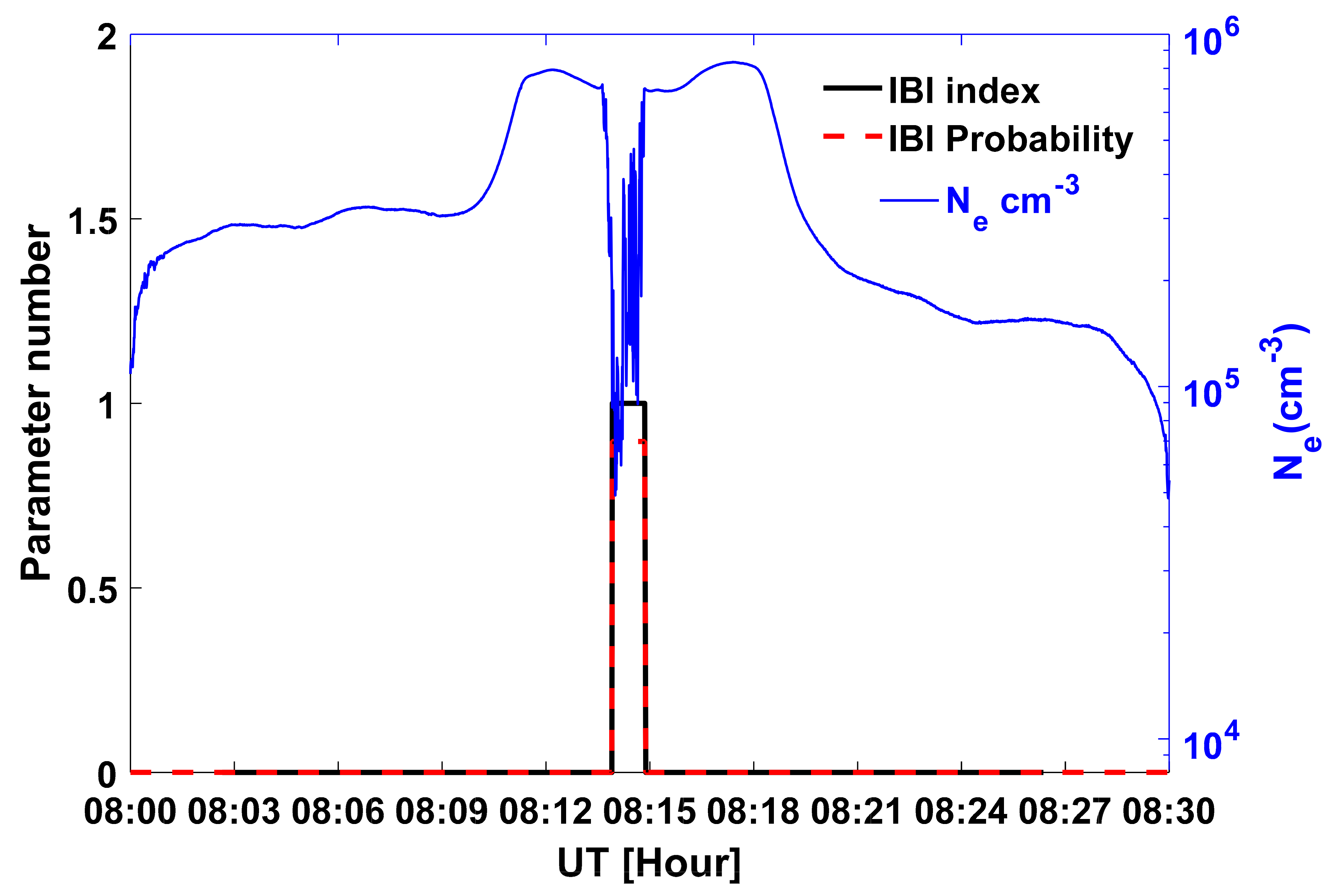
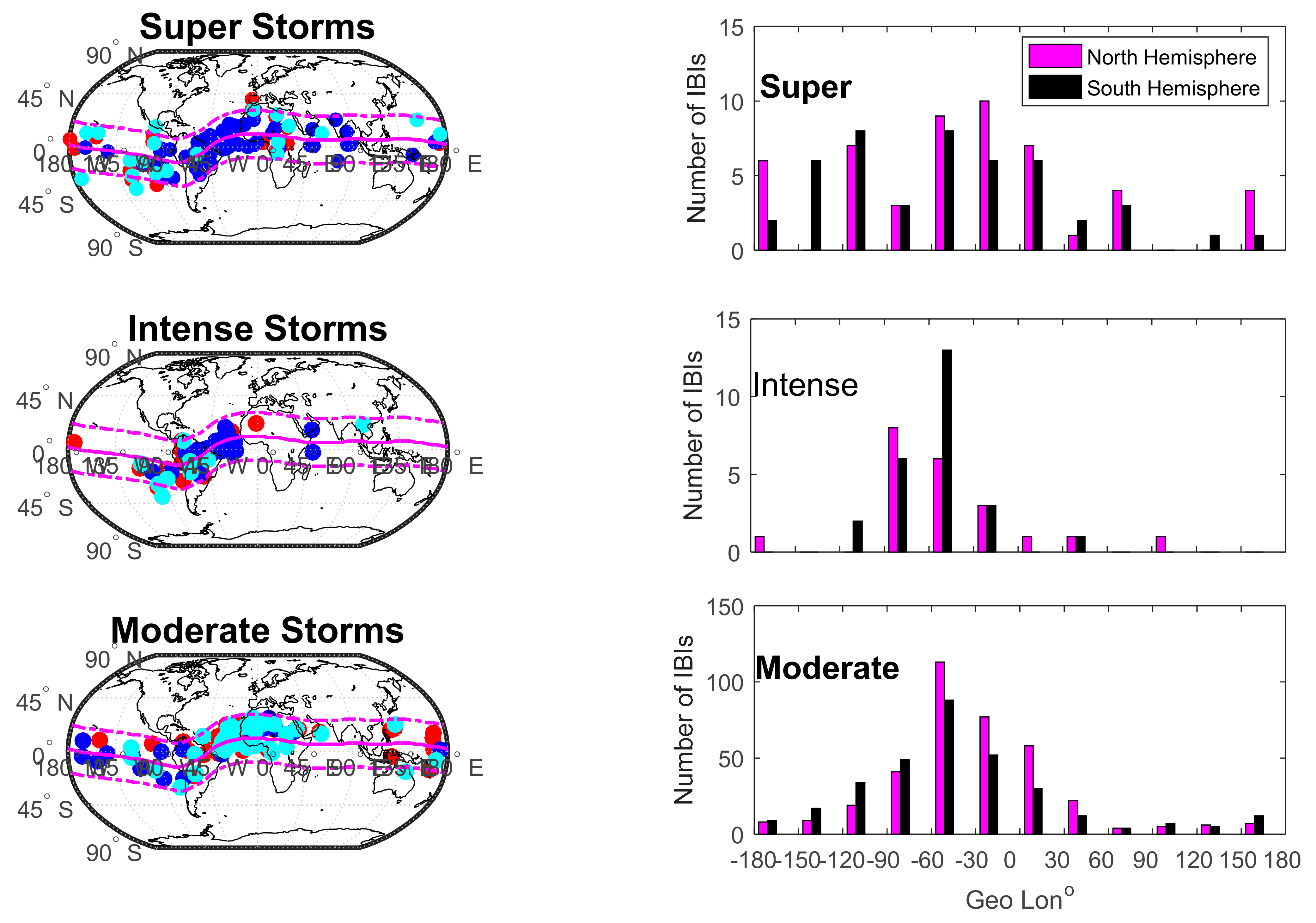
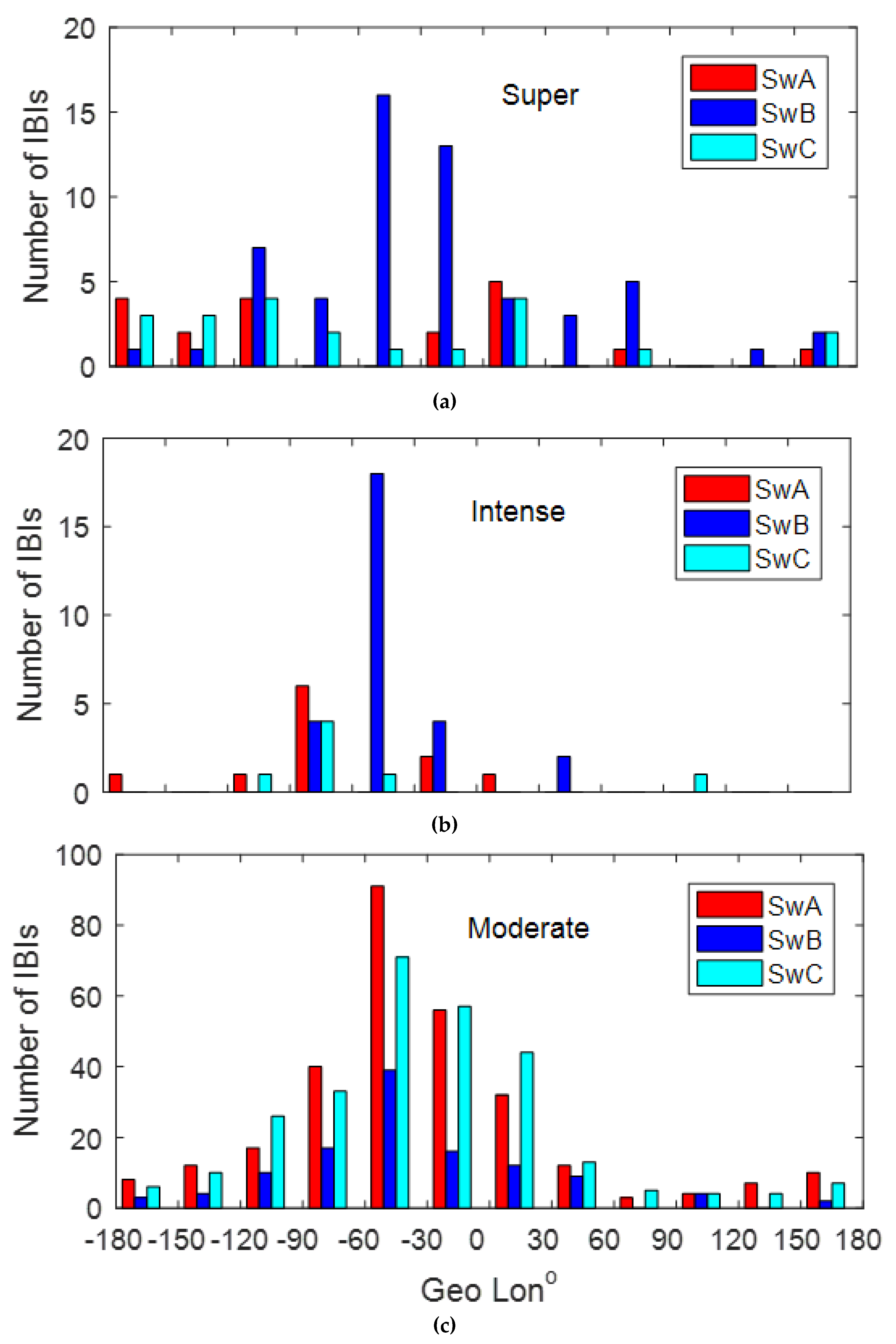
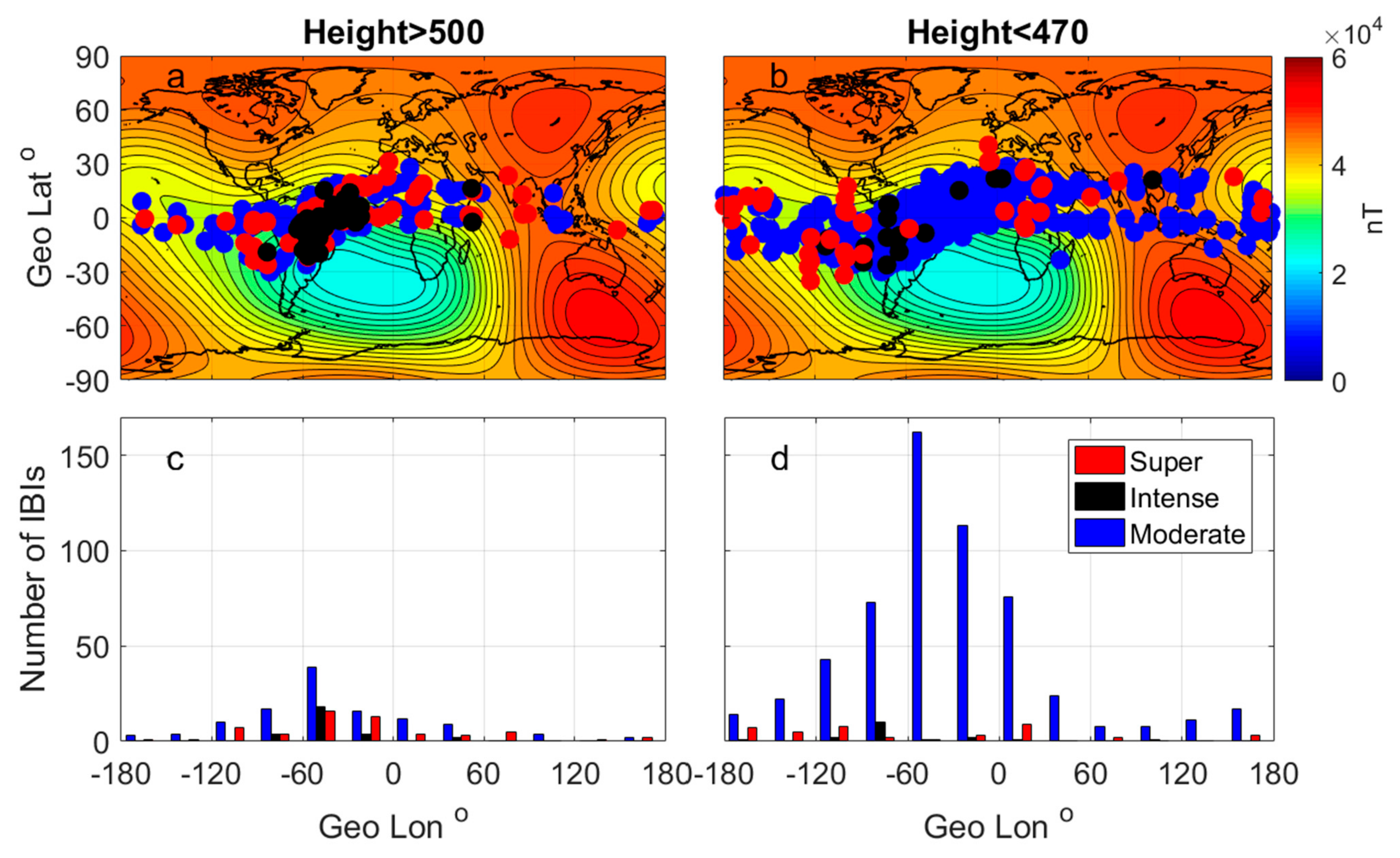
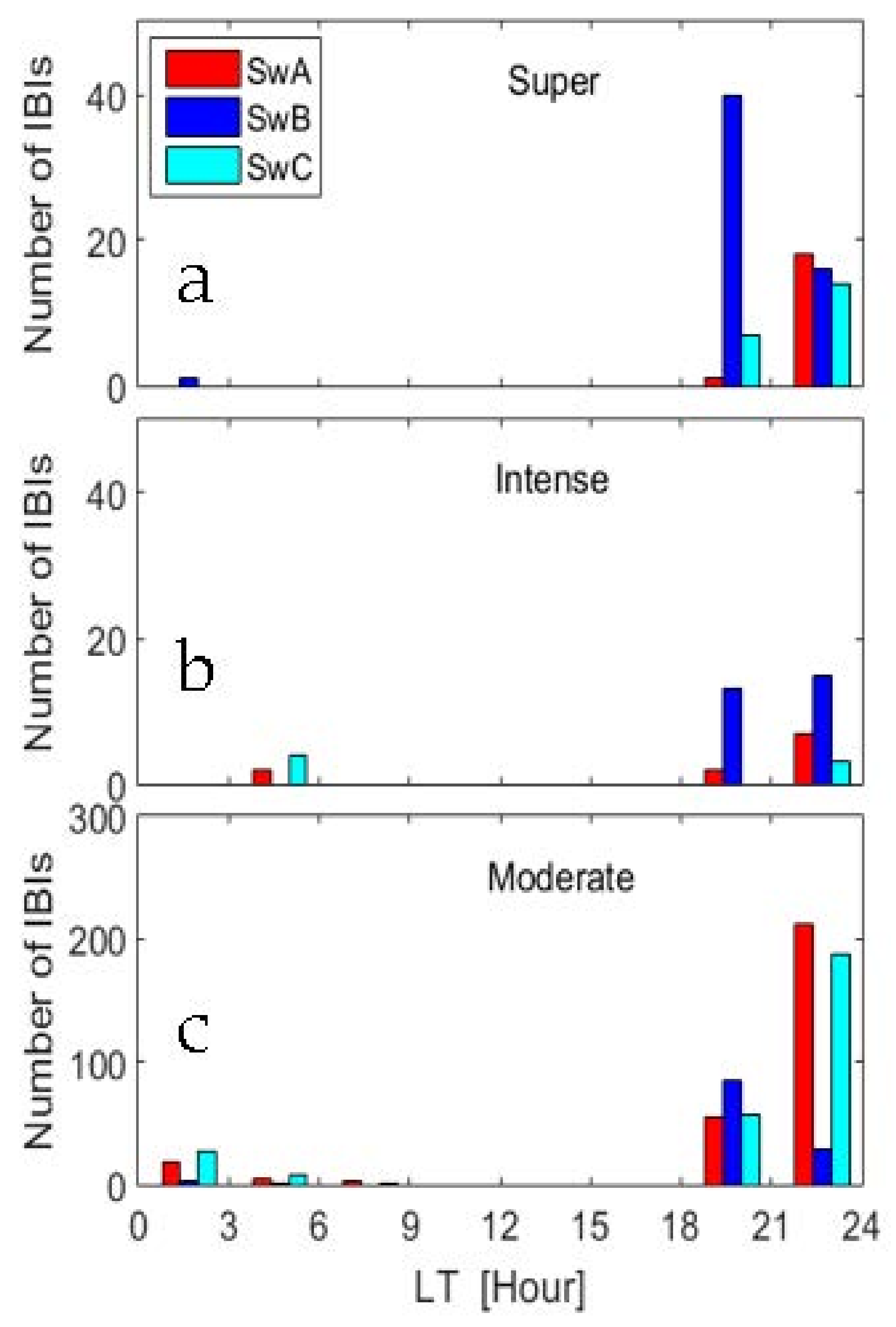
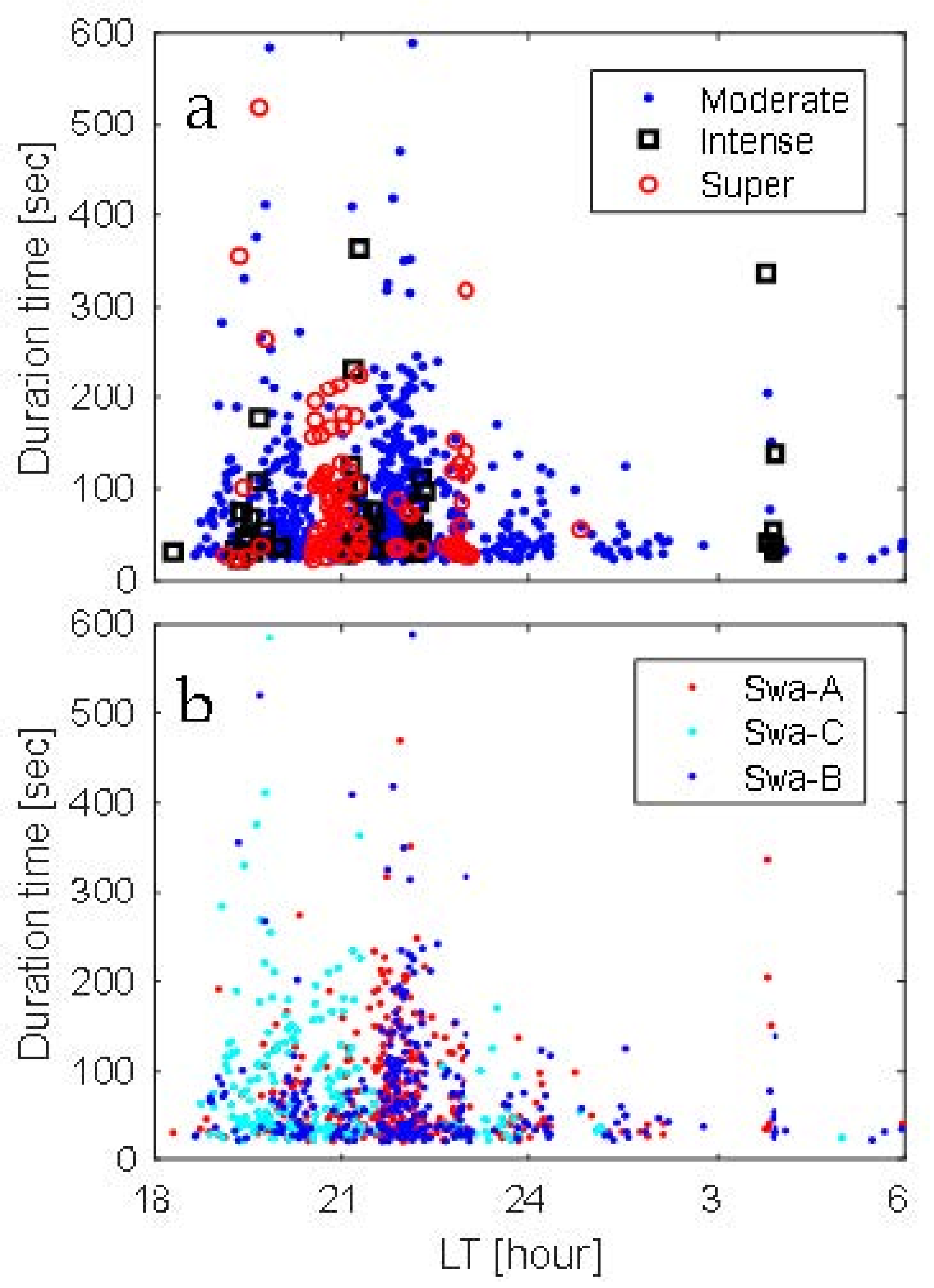
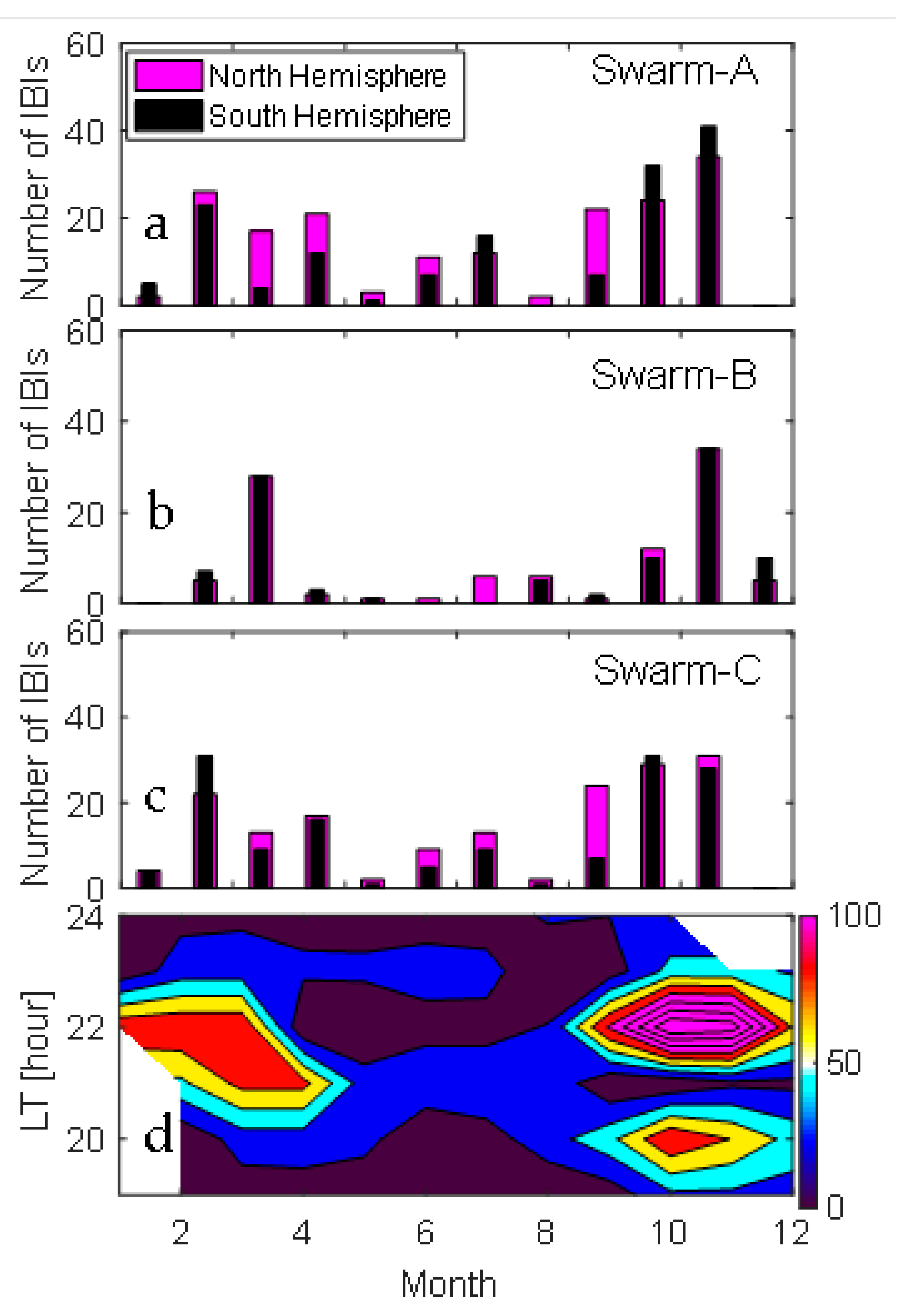
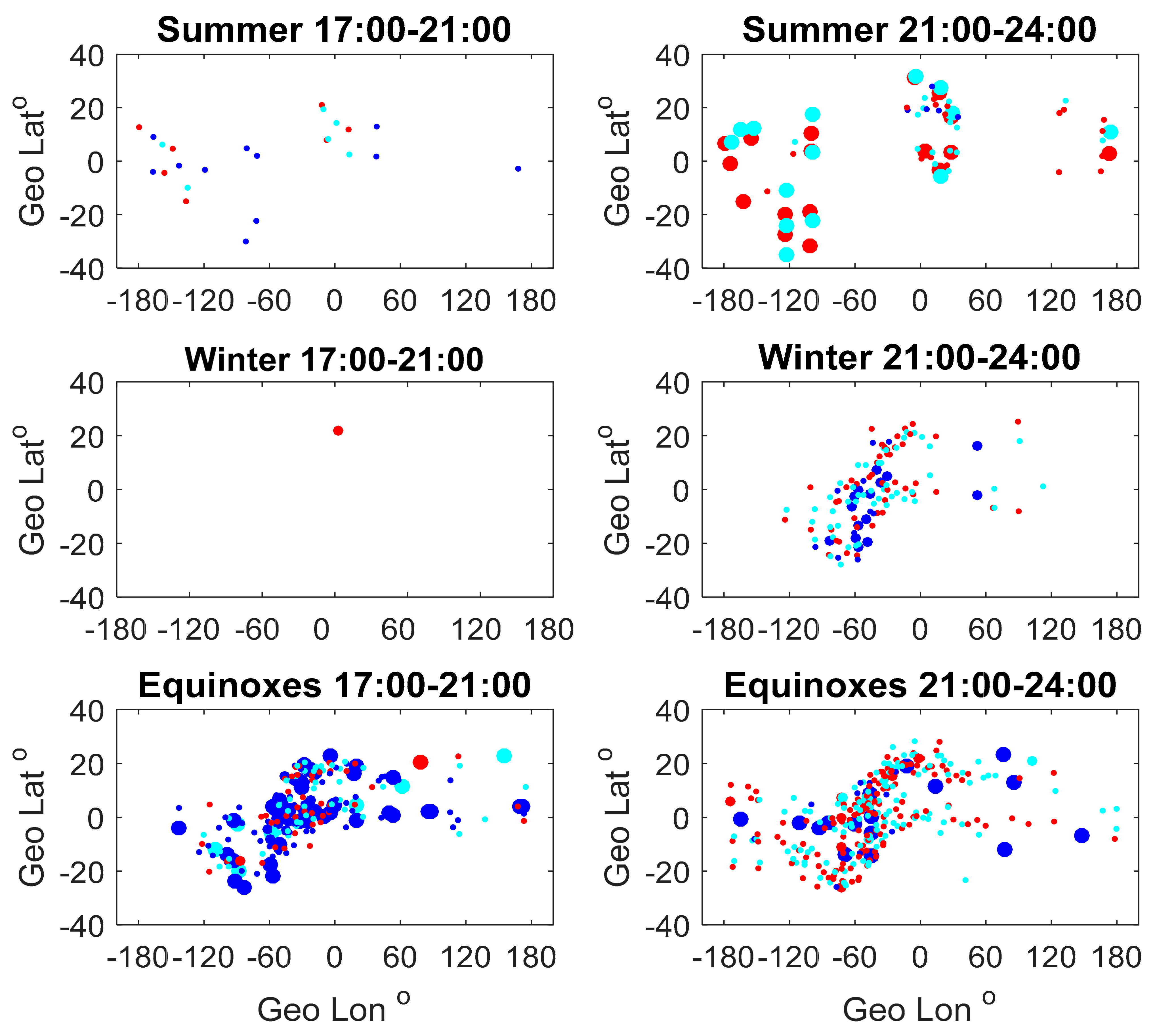


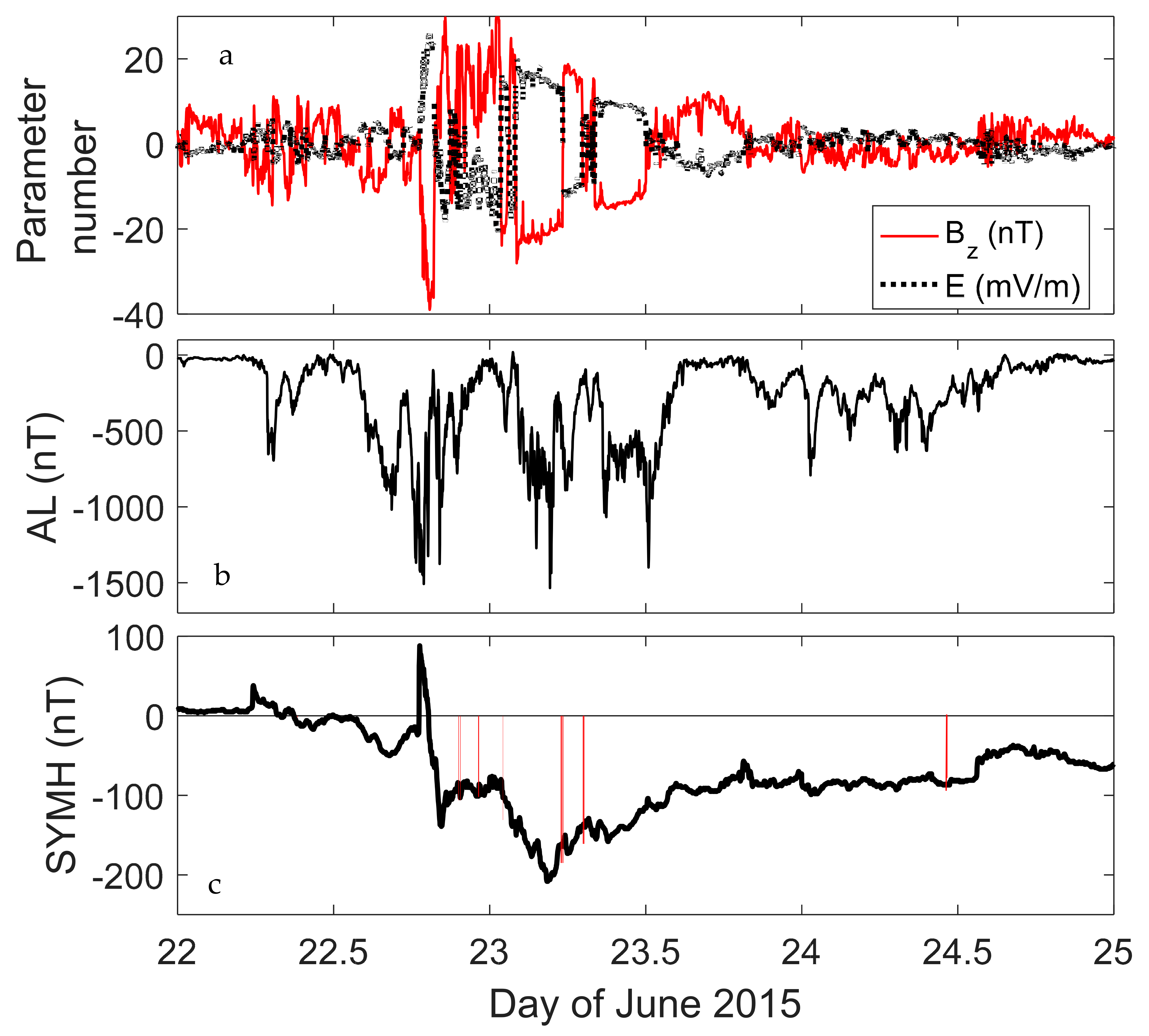
| Bubble Index | Description |
|---|---|
| 0 | Quiet |
| 1 | Bubble |
| −1 | Unanalyzable |
| Start Date | Duration | Storm | Dst | Number of IBIs | Storm Driver | ||
|---|---|---|---|---|---|---|---|
| Year | Month | Day | (Days) | Type | (nT) | ||
| 2015 | 3 | 17 | 9 | Super | −223 | 64 | CME |
| 2015 | 6 | 21 | 11 | Super | −204 | 33 | CME |
| 2014 | 2 | 18 | 5 | Intense | −119 | 1 | Weak CME |
| 2015 | 12 | 19 | 5 | Intense | −155 | 15 | CME |
| 2015 | 12 | 31 | 5 | Intense | −108 | 0 | CME |
| 2016 | 10 | 12 | 8 | Intense | −104 | 19 | CME |
| 2017 | 5 | 27 | 4 | Intense | −125 | 1 | CME |
| 2017 | 9 | 7 | 5 | Intense | −142 | 10 | CME |
| 2018 | 8 | 25 | 6 | Intense | −174 | 0 | CME |
| 2014 | 2 | 23 | 4 | Moderate | −55 | 0 | CME |
| 2014 | 2 | 26 | 4 | Moderate | −97 | 2 | CME |
| 2014 | 4 | 29 | 6 | Moderate | −67 | 4 | Solar flare |
| 2014 | 8 | 26 | 10 | Moderate | −79 | 8 | CME |
| 2014 | 10 | 8 | 5 | Moderate | −51 | 101 | Negative IMF Bz |
| 2014 | 11 | 9 | 19 | Moderate | −65 | 83 | CME |
| 2014 | 12 | 23 | 2 | Moderate | −57 | 0 | CME |
| 2014 | 4 | 11 | 5 | Moderate | −87 | 5 | Negative IMF Bz |
| 2014 | 9 | 12 | 6 | Moderate | −88 | 23 | Double CME |
| 2015 | 2 | 16 | 7 | Moderate | −64 | 107 | Solar wind streamwind |
| 2015 | 4 | 15 | 6 | Moderate | −79 | 0 | CME |
| 2015 | 7 | 10 | 6 | Moderate | −61 | 26 | Solar wind stream |
| 2015 | 7 | 22 | 8 | Moderate | −63 | 4 | CME |
| 2015 | 8 | 22 | 9 | Moderate | −92 | 5 | Solar wind stream of solar wind |
| 2015 | 9 | 20 | 6 | Moderate | −75 | 1 | CME |
| 2015 | 9 | 7 | 14 | Moderate | −98 | 1 | CME |
| 2015 | 11 | 2 | 5 | Moderate | −60 | 26 | Solar wind stream |
| 2015 | 11 | 6 | 10 | Moderate | −89 | 92 | CME |
| 2015 | 1 | 7 | 9 | Moderate | −99 | 7 | Negative IMF Bz |
| 2015 | 4 | 9 | 5 | Moderate | −75 | 7 | CME |
| 2015 | 6 | 7 | 6 | Moderate | −73 | 6 | CIR |
| 2015 | 7 | 4 | 7 | Moderate | −67 | 20 | CME |
| 2015 | 8 | 15 | 7 | Moderate | −84 | 7 | CME |
| 2016 | 2 | 2 | 3 | Moderate | −53 | 1 | CIR |
| 2016 | 2 | 15 | 8 | Moderate | −57 | 3 | CME |
| 2016 | 3 | 14 | 8 | Moderate | −56 | 24 | CME |
| 2016 | 4 | 2 | 6 | Moderate | −59 | 30 | CIR |
| 2016 | 4 | 12 | 4 | Moderate | −59 | 19 | CME |
| 2016 | 4 | 15 | 3 | Moderate | −55 | 8 | CME |
| 2016 | 8 | 2 | 7 | Moderate | −52 | 0 | CME |
| 2016 | 8 | 23 | 5 | Moderate | −74 | 3 | Solar wind stream |
| 2016 | 11 | 9 | 7 | Moderate | −59 | 0 | CME |
| 2016 | 1 | 19 | 7 | Moderate | −93 | 8 | CME |
| 2016 | 5 | 7 | 8 | Moderate | −88 | 3 | CME |
| 2016 | 3 | 5 | 7 | Moderate | −98 | 11 | CIR |
| 2017 | 3 | 26 | 11 | Moderate | −74 | 2 | Coronal hole |
| 2017 | 9 | 27 | 8 | Moderate | −76 | 39 | CME |
| 2017 | 11 | 7 | 9 | Moderate | −94 | 0 | CME |
| 2017 | 7 | 16 | 5 | Moderate | −72 | 0 | CME |
| 2018 | 5 | 5 | 9 | Moderate | −56 | 1 | Solar wind stream |
| 2018 | 9 | 10 | 7 | Moderate | −60 | 0 | CME |
| 2018 | 11 | 4 | 11 | Moderate | −53 | 1 | CME |
| 2018 | 4 | 19 | 8 | Moderate | −66 | 0 | CME |
| 2018 | 10 | 7 | 7 | Moderate | −53 | 0 | CME |
| 2019 | 8 | 4 | 8 | Moderate | −50 | 0 | CME |
| 2019 | 5 | 10 | 4 | Moderate | −51 | 0 | CME |
| 2019 | 5 | 13 | 3 | Moderate | −65 | 0 | CME |
| 2020 | 2 | 17 | 10 | Moderate | −52 | 0 | Negative IMF Bz |
| 2020 | 4 | 20 | 2 | Moderate | −59 | 0 | CME |
| 2020 | 7 | 23 | 5 | Moderate | −52 | 0 | CME |
Publisher’s Note: MDPI stays neutral with regard to jurisdictional claims in published maps and institutional affiliations. |
© 2021 by the authors. Licensee MDPI, Basel, Switzerland. This article is an open access article distributed under the terms and conditions of the Creative Commons Attribution (CC BY) license (https://creativecommons.org/licenses/by/4.0/).
Share and Cite
Hussien, F.; Ghamry, E.; Fathy, A. A Statistical Analysis of Plasma Bubbles Observed by Swarm Constellation during Different Types of Geomagnetic Storms. Universe 2021, 7, 90. https://doi.org/10.3390/universe7040090
Hussien F, Ghamry E, Fathy A. A Statistical Analysis of Plasma Bubbles Observed by Swarm Constellation during Different Types of Geomagnetic Storms. Universe. 2021; 7(4):90. https://doi.org/10.3390/universe7040090
Chicago/Turabian StyleHussien, Fayrouz, Essam Ghamry, and Adel Fathy. 2021. "A Statistical Analysis of Plasma Bubbles Observed by Swarm Constellation during Different Types of Geomagnetic Storms" Universe 7, no. 4: 90. https://doi.org/10.3390/universe7040090






